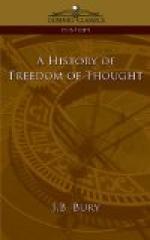[142] not adopt the line of arguing that miracles are incredible or impossible. He examines the chief miracles related in the Gospels, and shows with great ability and shrewd common sense that they are absurd or unworthy of the performer. He pointed out, as Huxley was to point out in a controversy with Gladstone, that the miraculous driving of devils into a herd of swine was an unwarrantable injury to somebody’s property. On the story of the Divine blasting of the fig tree, he remarks: “What if a yeoman of Kent should go to look for pippins in his orchard at Easter (the supposed time that Jesus sought for these figs) and because of a disappointment cut down his trees? What then would his neighbours make of him? Nothing less than a laughing-stock; and if the story got into our Publick News, he would be the jest and ridicule of mankind.”
Or take his comment on the miracle of the Pool of Bethesda, where an angel used to trouble the waters and the man who first entered the pool was cured of his infirmity. “An odd and a merry way of conferring a Divine mercy. And one would think that the angels of God did this for their own diversion more than to do good to mankind. Just as some throw a bone among a kennel of hounds for the pleasure of seeing them
[143] quarrel for it, or as others cast a piece of money among a company of boys for the sport of seeing them scramble for it, so was the pastime of the angels here.” In dealing with the healing of the woman who suffered from a bloody flux, he asks: “What if we had been told of the Pope’s curing an haemorrhage like this before us, what would Protestants have said to it? Why, ’that a foolish, credulous, and superstitious woman had fancied herself cured of some slight indisposition, and the crafty Pope and his adherents, aspiring after popular applause, magnified the presumed cure into a miracle.’ The application of such a supposed story of a miracle wrought by the Pope is easy; and if Infidels, Jews, and Mahometans, who have no better opinion of Jesus than we have of the Pope, should make it, there’s no help for it.”
Woolston professed no doubts of the inspiration of Scripture. While he argued that it was out of the question to suppose the miracles literally true, he pretended to believe in the fantastic theory that they were intended allegorically as figures of Christ’s mysterious operations in the soul of man. Origen, a not very orthodox Christian Father, had employed the allegorical method, and Woolston quotes him in his favour. His
[144] vigorous criticisms vary in value, but many of them hit the nail on the head, and the fashion of some modern critics to pass over Woolston’s productions as unimportant because they are “ribald” or coarse, is perfectly unjust. The pamphlets had an enormous sale, and Woolston’s notoriety is illustrated by the anecdote of the “jolly young woman” who met him walking abroad and accosted him with “You old rogue, are you not hanged yet?” Mr. Woolston answered, “Good woman, I know you not; pray what have I done to offend you?” “You have writ against my Saviour,” she said; “what would become of my poor sinful soul if it was not for my dear Saviour?”




